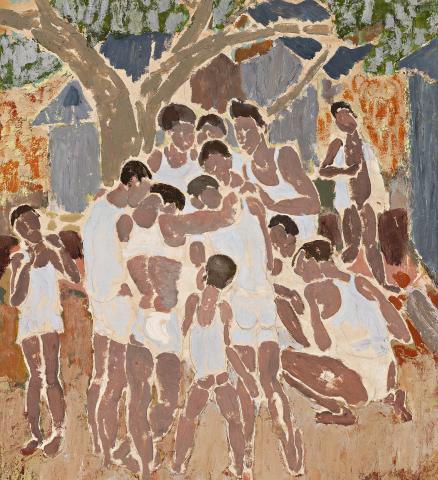NATIVE GROUP, DAVAO, PHILIPPINES, 1934
IAN FAIRWEATHER
oil and pencil on cardboard
45.5 x 41.0 cm
Redfern Gallery, London (label attached verso)
W.J. Freshfield Esq., London, acquired from the above February 1935
Private collection, Sydney
Private collection, Melbourne
Ian Fairweather, Redfern Gallery, London, 9 January – 1 February 1936, cat. 43, as Native Group
Bail, M., Ian Fairweather, Bay Books, Sydney and London, 1981, pl. 10, p. 37 (illus.), p. 39
Bail, M., Fairweather, Murdoch Books, Sydney and London, 2009, cat. 19, pl. 14, p. 34 (illus.), p. 35, p. 246
From Colombo to Melbourne, then on to Davao in the Philippines via Sydney and Brisbane, 1934 saw Ian Fairweather continuing his ever-peripatetic ways. His stay in Melbourne included friendships with Lina Bryans, William Frater and George Bell, a solo exhibition at Cynthia Reed’s in Little Collins Street, of some twenty unframed oils on paper or cardboard, and a mural commission for the Menzies Hotel. In London, the Contemporary Art Society acquired his Bathing Scene, Bali 1933 for presentation to the Tate Gallery. In Melbourne he left behind such masterly works as Chinese Mountain, c.1933, with William Frater, through Lina Bryans to the Art Gallery of New South Wales; and Head of a Woman, c.1933, from Dr and Mrs Clive Stephen to the National Gallery of Victoria. The next wave of paintings, to which Native Group, Davao, Philippines, 1934, belongs, include Voyage to the Philippines, c.1934, (private collection, London), and Māra 1934 in the Art Gallery of South Australia – rarities – in aesthetic appeal and number.
During his few months at Davao (he had left for Shanghai by mid-December) Fairweather lived in a house on stilts, described in a letter of about late September to Frater in Melbourne: ‘…amongst the coconut trees – on the very edge of the beach – there is a kind of village stretching along the shore – underneath my house there are boats, babies, sand, pigs – chickens.’1 His art embraced the life about him. Even in his more figurative works as Native Group, Davao, Philippines, 1934, one cannot but admire the formal sense of structure, colour and painterly appeal. Reviewing his London Redfern Gallery show in which this painting was exhibited, the art critic for The Times commented that Fairweather was ‘a subtle colourist with a preference for the “earth” range, though, … he does not avoid brighter notes when they serve his purpose.’2 Restricted as his palette may be, the colours almost sing in harmony. The application of paint and the support showing through give the work a vivacity related not only to its subject, but also to the overall abstract freedom, carefully considered and aided by the effective use of diagonals. The ongoing influence of Cézanne translates from technique into celebration especially in the play between painted and unpainted surfaces. The wonderful calligraphy of his later works can be sensed in the flow of line harmonizing with the patchwork play of light. Surfaces almost flicker, seen again in Māra and the continuation of that interplay between volume and animated picture plane. Murray Bail identified the scene as a cluster of ‘twelve village youths in singlets and shorts around a cock-fight or spider fight, without overcrowding: a fine impression of forms, of concentrated idleness’.3 While people populate such paintings, it is not their individualities that Fairweather seeks to capture, rather people as part of the great cavalcade of life.
1. Bail, M., Fairweather, Murdoch Books, Sydney, 2009, p. 35
2. ‘Mr. Ian Fairweather’, The Times, London, 11 January 1936, p. 10
3. Bail, M., op. cit., p. 35
DAVID THOMAS
